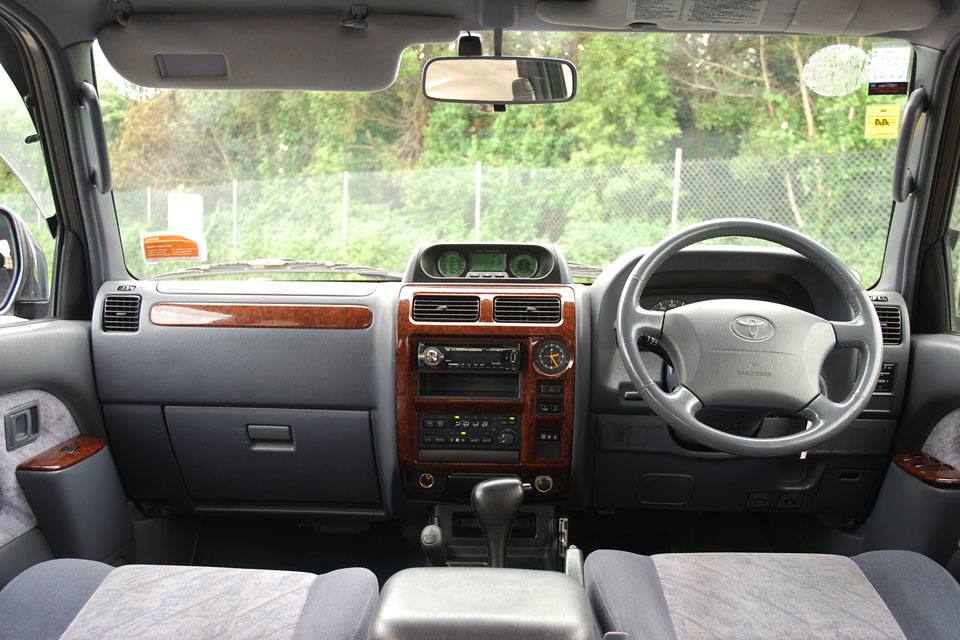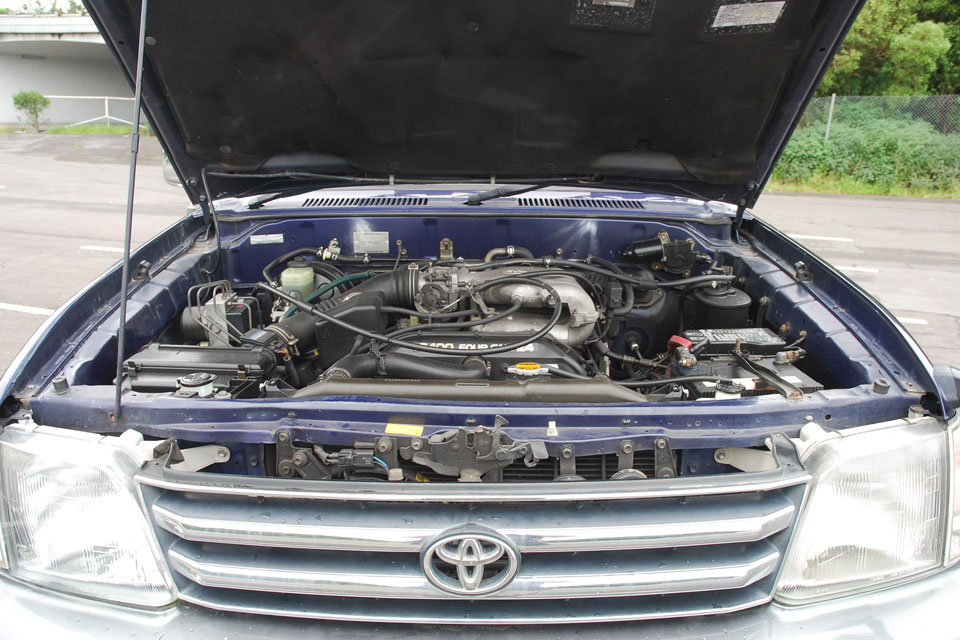Toyota Land Cruiser Prado 1996-2002 used car review
The Toyota Land Cruiser Prado is excellent off-road and has seats for eight. It is truck-like to drive on the road.

The Toyota Land Cruiser Prado is excellent off-road and has seats for eight. It is truck-like to drive on the road.
The Toyota Land Cruiser Prado is a large SUV that can handle either the school run or tackle serious off-road conditions. It has a robust separate chassis for durability and load capacity. Although a short-wheelbase three-door model was available, it is sold only as a long-wheelbase five-door in New Zealand.
Inside and out
The Prado is big and boxy, with a tall and narrow overall look. The front has a bluff, squared-off nose with a simple two-slat grille and grey plastic bumpers. The side features grey plastic cladding which resists parking damage. The rear door swings open to the right and carries the spare tyre.
The boxy design continues inside with a mostly rectangular and very upright dash, and a squarish pod for the instruments. On top of the centre console is a pod with off-road-centric gauges.
Below it is an aftermarket stereo and climate controls. These are so low you need to take your eyes off the road to adjust them, so be careful. All the materials feel robust and very durable.
The seats are covered in plush grey fabric and are firm yet comfortable and supportive. The second and third rows are both short on legroom and the seat height is oddly close to the floor. Headroom is excellent.
Access to the three-seat third row is by pulling a lever to fold and tilt the second row forward. It doesn't split, which can be annoying if you are getting people into the third row when a car seat is in place.
The third row does split, which allows flexibility between seating and storage. With the row in place, you can carry two medium-sized cases in the boot, or you can fold one seat or both of the halves up to the side of the car for more space - enough for six or more large cases or even a few kids’ bikes. The seats are, however, very heavy and might be difficult for smaller or less mobile people to raise.
On the road
Four engines are available in this generation Prado. Most common is a 3-litre turbocharged diesel engine, while basic import models feature a 2.7-litre four-cylinder petrol motor. A non-turbo 2.8-litre engine was sold briefly in 1996. Our review vehicle is powered by a 3.4-litre six-cylinder petrol.
Transmissions are either four-speed automatic or five-speed manual, with the standard four-wheel drive. The six-cylinder engine produces 136kW and 294Nm, which is low for an engine of this size. Performance is reasonable, although the engine likes to make quite a loud roar when it is pushed.
If you are shopping for diesel be aware that an intercooler, which improves performance and reliability, was added to the engine in 1999.
The Prado does not drive like a car. The steering is light, vague and slow to respond to input. There is a lot of body roll when you corner, though it doesn't feel unstable. Full-time four-wheel drive helps on slippery surfaces and a gauge on the dash shows which wheels are getting power at any time.
The Prado is very capable off-road where its high ground clearance, excellent approach and departure angles allow it to tackle climbs and ruts with ease. The transmission can be switched to low range for particularly tricky conditions.
The high seat positions allow you to see a long way, though vision immediately around the car is restricted. Japanese-import models feature additional mirrors on the front passenger corner and the rear door - they are surprisingly useful for working out where the edges of the car are.
We think it would be helpful to add a reversing camera and front parking sensors. You can buy a camera to fit yourself from $50 or have a professional do it from $200.
The Prado’s tow rating is excellent, better than even utes of its era. It can handle 750kg unbraked, (a medium-sized garden trailer) and 2,500kg braked (a medium to large trailer boat.)
Safety
RightCar lists the Prado (1996-2003) as having a four-star Used Car Safety Rating, based on real-world crash data. Safety feature levels are not particularly high, with only driver and passenger airbags and antilock brakes.
Some later high-end models, mostly New Zealand-new, feature traction control and electronic stability control, indicated by a “VSC” button on the dashboard. Airbags were optional on entry-level models, so check the car you are considering has them.
The centre seatbelts in the second and third rows are the lap-only type and do not offer as much protection as full shoulder-type belts. There are no ISOFIX child seat mounts, though the second row does have tether points.
Reliability
The Toyota Land Cruiser Prado has a reasonable record for reliability, though at this age most have been heavily used and show signs of wear. The heavy-duty components can be costly to replace. The 3.4-litre engine has a cam belt which will require regular replacement.
Although they’re solid and durable, the differentials and suspension can wear out, particularly for off-road use. Listen for unusual sounds from under the vehicle when driving and check the tyres for uneven wear. If any of these appear, reconsider the vehicle - it could be a sign of expensive issues to come.
The inner front mudguard liner panels are prone to cracking. This is caused by the vehicle being used in extreme off-road conditions or for towing heavy loads. It's not an issue in itself but more evidence of how hard the vehicle has been used.
Many Prados are fitted with aftermarket differentials and four-wheel drive accessories. Check the quality of each accessory and the fitment. Poorly fitted winches can put too much load on the front of the vehicle and cause cracks in the chassis.
Cost of ownership
Toyota recommends servicing the Prado every 12 months or 15,000km, whichever comes first, with services costing around $280 each for petrol models. The cambelt needs to be replaced every 100,000km, though at $450 it’s not expensive.
RightCar does not list official consumption figures for this model, but reports from Australia indicate petrol should cost around $4,340 a year for more than 14,000km. The 90-litre fuel tank will cost $180 to fill at $2 a litre and should take you 550km before the fuel light comes on. Some models are fitted with a second 68-litre reserve tank to extend the range.
A vehicle licence for the Prado costs $99.02 a year, with the car in the second cheapest ACC levy group.
Trade Me Insurance estimates insurance for a Prado valued at $11,280 will cost $46.11* per month, slightly more than a Mitsubishi Pajero.
Buyers' guide
This generation of Prado is available on Trade Me priced from $4,500 to $26,000 for later and lower mileage vehicles. Cars under $8,000 are likely to have travelled more than 300,000km or be well worn, but even in that condition, they are still worth good money.
Japanese models
- TS - Features steel wheels, power windows, black plastic bumpers, climate control air-conditioning and five seats - essentially an off-road specification.
- TX – Adds alloy wheels, silver bumpers, side steps and roof rails.
- TZ – Adds driving lights, rear air-conditioning, sunroof, wood trim and keyless entry.
The three-door model is available in the same versions, though they are called the RS, RX and RZ respectively.
New Zealand-new models
- LX – Features steel wheels, fabric interior, vinyl trim and manual air-conditioning (rear air-conditioning added in 1999).
- RV – Adds painted bumpers, fabric seats and carpet and alloy wheels.
- VX (SR5 till 1999) – Adds rear air-conditioning zones, refrigerator, electric driver's seat, leather steering wheel and cruise control.
- VX Limited – Adds leather upholstery, heated front seats and sunroof.
Timeline
- 1996 - Launched internationally
- 1999 - Intercooler added to diesel
- 1999 - Small cosmetic and specification changes, with seven-seat option made available
- 2002 - Replaced by new model
Details
1998 Toyota Land Cruiser Prado TZ
$11,000 to $24,000 for models which have travelled 70,000 to 120,000km
3.4-litre six-cylinder petrol 136kW/294Nm (claimed)
Four-speed automatic, four-wheel drive
Four-star Used Car Safety Rating (NZ model)
15,000km or twelve months
Full size wheel
15.5-litres per 100km
Regular
4690mm
1820mm
1880mm
750kg (unbraked), 2500kg (braked)
5.7m (radius)
This review covers the Toyota Land Cruiser Prado for model years 1996, 1997, 1998, 1999, 2000, 2001 and 2002.
Review vehicle supplied by Turners Cars.
*Our insurance estimates are based on a 35-year-old male with no accidents in the last two years, garaging the car in Mission Bay, Auckland. The car is not used for business and will cover 10,000km to 20,000km a year. We estimate with no option add-ons and $500 excess. Customise your estimate at Trade Me Insurance.
Image gallery
Also consider






